Pumpkin Drawing Step by Step
This week, I wish you Happy Halloween with this pumpkin drawing tutorial. Draw one pumpkin or many, make a simple drawing or an atmospheric illustration – these easy ideas have many possibilities!

My drawing is about 29 x 29 cm (11,5 x 11,5 inches) but you can use these ideas for any size. Start with one pumpkin and then decide if you want more. I started from one on the left bottom corner.

Even if the pumpkin looks very decorative and detailed, it’s fun to color with colored pencils. But first, we make a simple sketch.
Step #1 – Sketch a Pumpkin
Pick a pencil and sketch a pumpkin. Start from a circle and then divide it into sections.

I also added one vertical and one diagonal line to mark the perspective. But as you can see in the image below, my guiding lines for the perspective are short ones. They only define a very small section of the background.

After coloring the first pumpkin, we will add more guidelines to the background.
Step #2 – Decorate a Pumpkin
For each section, color a column of simple circles.

Use zigzag strokes and have fun with colors.
Step #3 – Color the Rest of the Pumpkin
Add a background color for each section.

Leave some white around every circle to get more decoration. You can now decorate the stem too.
Pick a yellow pencil and color over the pumpkin. Yellow adds wamth and makes the colors shine.

Step #4 – Add Shadows and Finish the Pumpkin
Add some shadows around the pumpkin and in the centre.

You can now adjust the decorations and make sure that you have colored the pumpkin carefully. The coloring should cover the paper.
Step #5 – Start the Background Patterning
No matter how big your drawing will be, I suggest that you first focus on the surroundings of the first pumpkin. This is “the seed pumpkin” or “the mother pumpkin.” Draw a safe place for her first before drawing more.
By following the guides from the first step, color checkered patterns.

Use a neutral color. You can later add more color on them.
Step #6 – Draw More Pumpkins
Imagine the magic – so, pumpkins flying freely in the space! With a pencil, draw pumpkins in different sizes.

Make sure that some of the pumpkins are only partly visible and that they are oriented in different directions.

First draw a circle and mark the orientation with the stem. Then divide each pumpkin into sections.
Step #7 Color More Pumpkins and Expand the Background Patterning
Now you can let go with the stiff idea of a perspective and make your own. Color the checkered patterns so that they flow in different directions. Again, use neutral colors for them. You can leave a small part of the background without patterning.

At the same time, you can start coloring the pumpkins as well. Change the orientation of the paper while coloring so that your little squares and circles don’t get distorted.

If you were a little careless when sketching (like I was), the pumpkins may look less like pumpkins and more like decorated circles. Add little bumps to the sections between the ribs to correct this.

Step #8 – Color the Background and Finish Your Pumpkin Drawing
The idea of background patterning is to get a sketch for “the air” – so for the 3-dimensional space where the pumpkins are flying. You can now color over the neutral grid and add new checkered patterns with colors as well.

Get creative and let all kinds of fun stuff appear in the background!

To get the festive feel, spend some extra time with the drawing to make sure your colors are strong, your darks are dark, and the paper doesn’t peek through. What started as a simple pumpkin can now become pumpkin art!

Happy Halloween!
P.S. If you liked this tutorial, check the course Fun Botanicum!
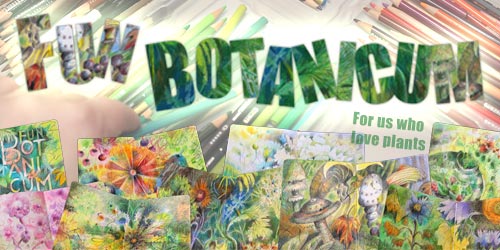
Abstract Watercolor Flower Card
This week, I invite you to paint with me. Let’s make an abstract watercolor flower card!
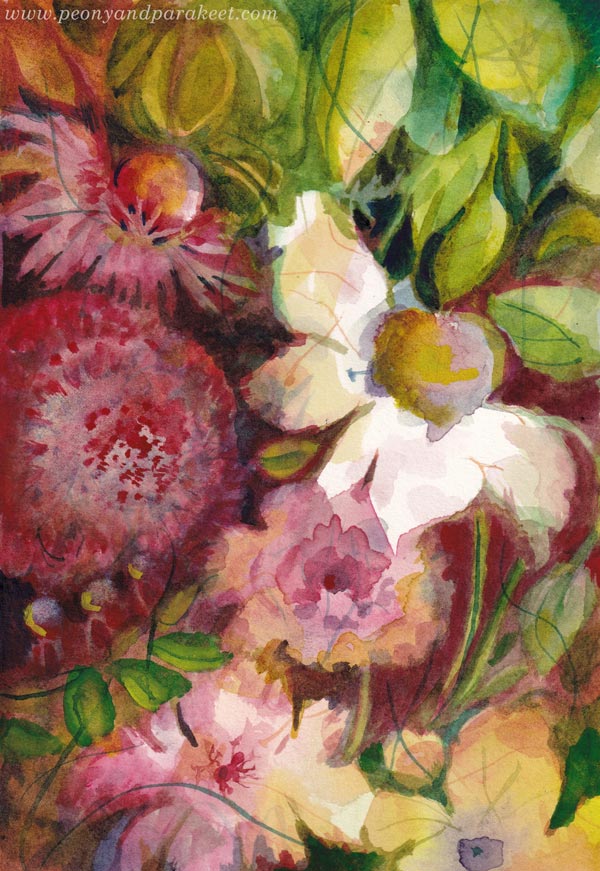
Abstract Watercolor Flower Card – Watch the Video!
In this video, you see me both creating and talking about abstract floral art. Watch the video and paint with me!
I hope my love for abstract florals is contagious! Here’s the finished card again.
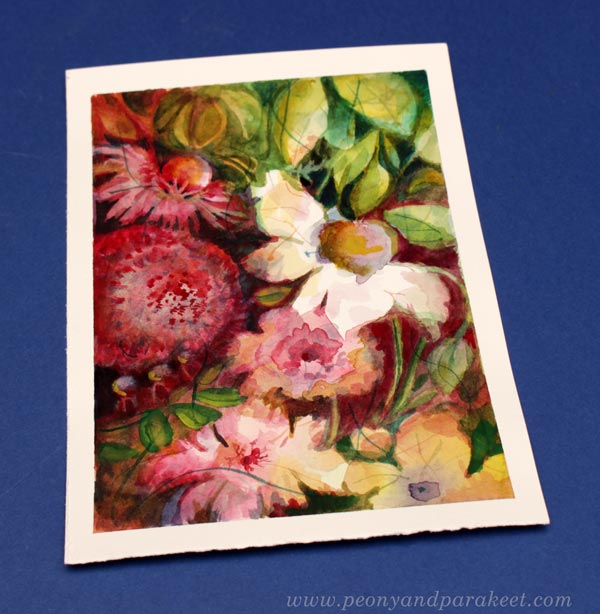
Watercolor cards are just precious. You can never have too many, and there’s always someone you gan give one to. That’s why the new course Wild Garden has many card projects.
Wild Garden – Paint with Me!
In the upcoming course Wild Garden we will paint flowers freely, intuitively, and expressively in watercolor. Sign up here!
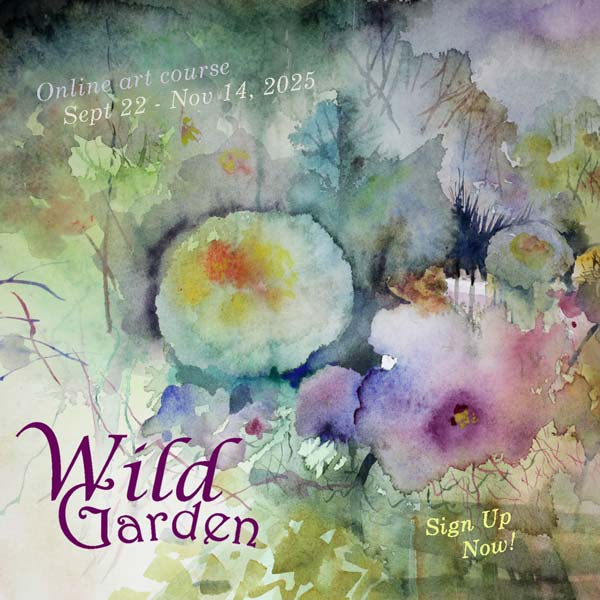
Wild Garden will begin on September 22, 2025. Sign up now!
Intuitive Flowers with Colored Pencils
This week, we take an intuitive approach to flowers and color them freely with colored pencils. This method can also be easily adapted to watercolors.

Everyone’s flowers are different, but we can all start with the same steps. I will show you how to start and how to bring intuition into the process, and then you can finish the piece in your own style.

Let’s get the colored pencils and start intuitive flowers step-by-step!
Step 1 – Background
Start by intuitively picking one main color. I choose a color that I feel strangely drawn to, or a pencil that looks a bit sad and needs some quality time with me. I may sharpen or re-arrange the pencils before I start, so that I feel more connection with them.
With the chosen pencil, color the paper lightly and softly. Leave a part of the center blank so that you will also have white in your work.

When you feel bored, add other colors for an energy boost and spiciness, but always get back to your main color. The main color sets the mood and makes sure that every flower will breathe the same air.
I use soft-tipped colored pencils, such as Prismacolor Premier and Caran d’Ache Luminance. Thin layers are a joy to color and the strokes are soft. My paper is Fabriano Accademia Drawing Paper (200 gsm/94 lbs).
Step 2 – Circles
Color a new background layer so that you leave round areas uncolored. These are like ghosts that will be turned to flowers in the next step.

Make sure you have big, small, and medium circles, not just one size. Let some circles overlap and some disappear partly near the edges. This step is simple, but not very intuitive, because we tend to create circles of one size and separate from each other.
What does intuitive mean to you?
For me, it’s an emotional connection to colors and bringing out the spirit rather than the material. If you think intuitive is what feels easy, you’re holding back your development in making art.
Step 3 – Notches
Turn circles to flowers by coloring notches with the background colors. Make all kinds of shapes this way. I try to avoid symmetry, because flowers are rarely perfectly symmetrical. The more imaginative the shapes are, the more spirit I see in them.

You can also add some color to the flowers if it helps you to form a tighter connection, but do it only lightly in this step.
Step 4 – Colors
Add more colors – and not only to the flowers but also to the background. I like to think that the spirit of the flower is larger than its outline. The flower radiates the spirit, and the color of the flower is more in its surroundings than in the flower itself. This makes the background as fun to color as the flowers.

Make stems thin and curvy when you want the flowers to look delicate.
Step 5 – Repeat!
Add more details with the techniques of steps 1-4: more background color, more circles, more notches, more colors.

The more experienced you are, the more patience you have. Intuition is a rusty vehicle. The connection improves with time, and your piece will begin to speak to you.

Grow Your Skills at Fun Botanicum!
Fun Botanicum is a great course for all who want to grow their skills in drawing plants and learning more techniques for florals.
Intuitive Flowers and Colored Pencils
For me, being intuitive also means being flexible. I cherish every little flower, but also accept that not every flower can remain in the final piece.

A flower can bloom and give her soul to you, and then become a background spirit only. In this piece that happened a lot.

My drawing took about four hours to make.

What does intuitive mean to you? Do you aim for intuition when you are creating art?
Vermeer Girl With Heart – Draw With Me!
Draw a Vermeer girl by following my formula!

This drawing is a modern version of the painting “Girl with a Pearl Earring” by Johannes Vermeer. Here, the earring is not the center of the attention, but a heart and flowers steal the show. I have made a simple formula to draw and color the girl’s face, and then you can put your own twist on the head and add whatever decorations you want there.
Supplies
You can use colored pencils, watercolor pencils, watercolors, acrylic paints, oil paints – or any medium that has a possibility to create color mixes. My example uses colored pencils. For the face, you need three browns: one dark, one middle, and one very light brown. You also need a little bit red for the lips and black for some small details. White is optional. When working on white or almost white background, you can just leave the white areas uncolored as I do in my example. I do use a little bit white to blend the red of the lips into paper white.

I created my Vermeer girl directly on an art journal page. My art journal is Dylusions Creative Journal Square. Pick a journal or a paper that works well with your supplies.
Vermeer Girl – Shape by Shape Formula
To succeed you have to trust this formula. Don’t look at the original painting, follow the picture below only. Copy the shapes as accurately as you can, and don’t think about drawing a face. The girl will appear when you have all the puzzle pieces in place!
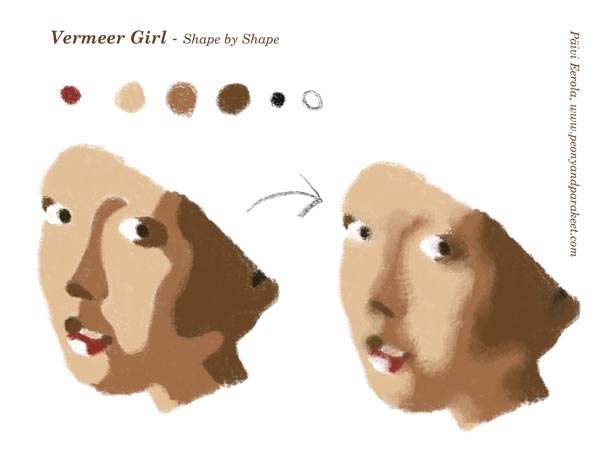
Start from the first picture and color the shapes so that they have sharp outline edges. Then blend the skin colors so that the transition from one shape to another is softer.
Starting the Drawing
If you want to put all kinds of fun stuff on the girl’s head, place the face on the left bottom corner. I marked the spot where I started the drawing with a green arrow on the photo below.
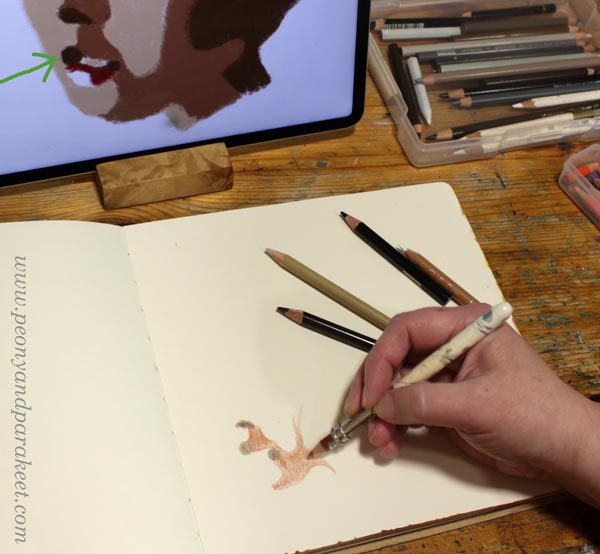
At first, the face doesn’t look like one at all. But this kind of abstraction will bring out the realistic look. Reality is always more abstract than we think.
Drawing Sharp Shapes
Human faces are very organic, so the shapes are too. Examine the curves of the formula in detail, and avoid straight lines. The more beginner you are, the more you are tempted to draw too straight, avoid that!
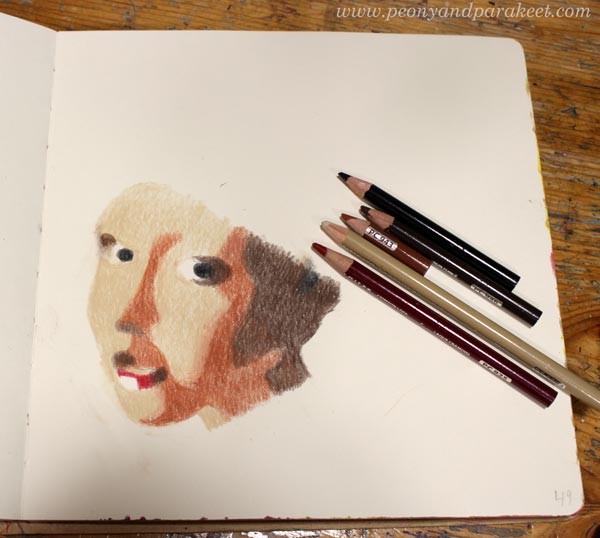
Once all the pieces are in place, the face makes sense. Take the image in front of the mirror to see if there are any distortions. If the mirror image looks wrong in some way, get back to the formula and check your shapes!

When you are satisfied with the sharp shapes, go to the second step of the formula: blending.
Vermeer Girl – Achieving the Old World Look
Old paintings have softness that our photo-oriented era doesn’t often express. We prefer sharpness over blurry. However, life is often blurry and your Vermeer Girl will look much more alive if you soften the edges of shapes, especially on the skin.

Color on the top of the shape with the neighbor color so that the shapes integrate and look less separate. Now you can also adjust the shapes a bit more freely. I lengthened the big dark brown shadow because my face became a bit longer than in the formula.
Small changes in faces can change the personality quite a lot. I think that’s fascinating! You can start from the Vermeer girl, but then end up with a character of your own.
Drawing Decorations
First, think about the size of the decorations: do you want plenty of small ones or only a few large ones. Beginners easily draw something between, but I think this portrait will look better if the decorations are either a bunch of small ones or a few large ones. I chose the latter and placed a couple of big flowers and a heart on her head.
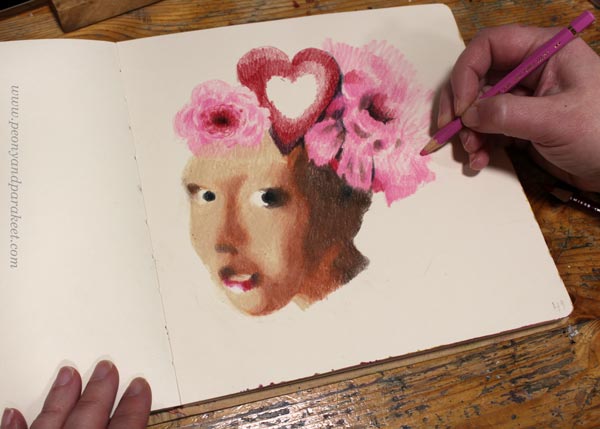
I colored the decorations freely and used no references for these. I like the contrast between the face’s carefully constructed softness and the free coloring of the flowers.
I move on to color the background just before I am finished with decorations. This way I can still change them a bit if needed. The background often gives life to the whole image and brings in more ideas for the drawing.
Starting the Background
Not only the girl’s face is composed of shapes, the background can be like that too. The only difference is that now you can freely improvise the shapes. Start with one color and sketch by coloring!
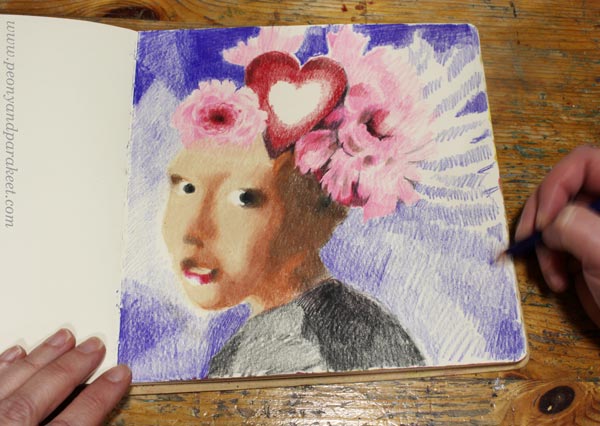
Think about the streams of air and imagine how the girl moves when she is posing in front of you.
Building the Color Scheme
To make the portrait look unified, you need to repeat the colors. My background started as blue, but in the picture below, it has started to get more brown tones. The pinks of the flowers also blend into blue. Color several layers and use a lot of blending near the edges.
I added the surrounding colors to the center of the heart like it would be a mirror. This also helps in harmonizing the atmosphere.
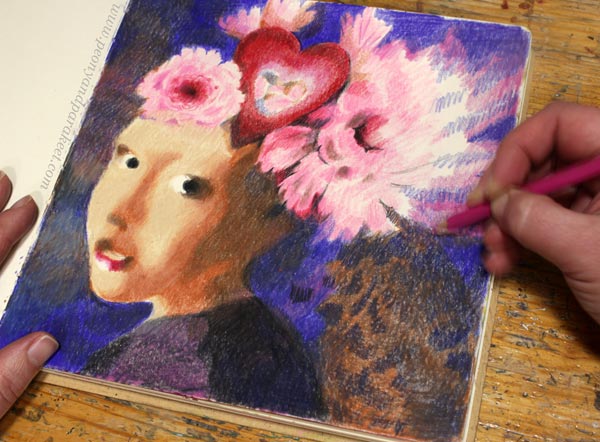
You can also play with patterns: color small shapes inside a bigger one! When located in the background, the patterns can be subtle and muted, so that they don’t steal the whole show.
Finishing the Vermeer Girl
When you are close to finishing, look at the original Vermeer painting and see how she partly disappears in the background. Especially the dark brown in the neck area can be blended with the background.

Dark background looks great with the lit face. Vermeer girl with a heart makes a wonderful Valentine’s day page in any art journal!

I hope this project made you grab your pencils and other art supplies!
Hearts and Stories – Sign up Now!
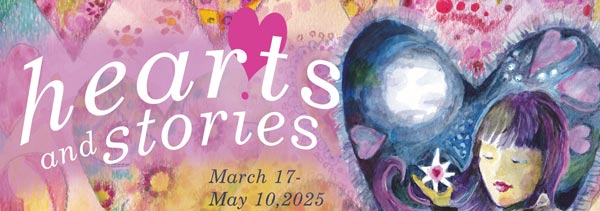
Come to play with hearts and other simple shapes! We use colored pencils, felt-tipped pens, and watercolors. Sign up for Hearts and Stories!